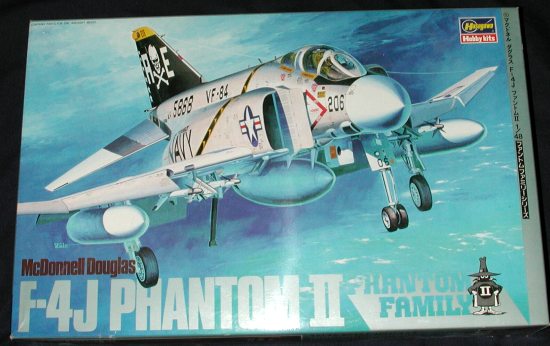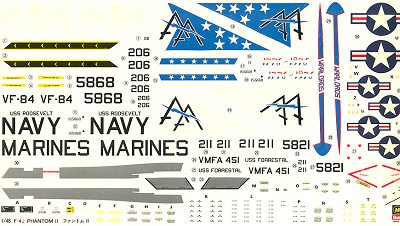
|
KIT: |
Hasegawa 1/48 F-4J Phantom II |
|
KIT # |
P1 (original) |
|
PRICE: |
$20.00 when new in 1984 |
|
DECALS: |
Two aircraft |
|
REVIEWER: |
|
|
NOTES: |
No longer available. Replaced by newer kit. |

|
HISTORY |
The F-4J was the final new build Naval Phantom. It incorporated a number of improvements over the earlier F-4B. The biggest visual difference was a clean radome without the IR seeker under it. It also had drooping leading edges that had a greater range of travel to improve landing characteristics, uprated avionics, and uprated J-79 engines to provide greater power and reliability. Other improvements included larger main wheels with a 'thicker' wing as used by USAF Phantoms, improved countermeasures equipment, a more powerful generator, increased fuel capacity, and a fixed inboard wing.
The first YF-4J (converted from an F-4B) flew in June of 1965 and the first production F-4J flew on May 1966. Production ended in January 1972 with 522 examples being built. The first combat cruises were made with VF-33 and Vf-102 aboard the USS America in May of 1968. A total of 32 war cruises were made with the F-4J. The Navy's only aces of the Vietnam war, Cunningham and Driscoll flew the F-4J while with VF-96. F-4Js were later converted to F-4S standard with leading edge slats, 'smoke-less' engines and a number of other updates. Final fleet squadrons for the F-4 were VF-151 and VF-161 aboard the USS Midway, who turned in their F-4s for F-18s in 1986. Following Navy wide retirement of the type in 1988, the only Navy unit to fly the type is the Navy Weapons Test Squadron at Pt. Mugu who are currently flying QF-4S drones.
|
THE KIT |

I guess that you could say that this is the kit that started it all. Though Monogram had an F-4J already on the market, Hasegawa's new Phantom was a major step forward in terms of detail and engineering. Originally released in 1979, it still has raised panel lines. Hasegawa didn't go completely over to engraved detail until the mid-1980's, though some of the Mania developed models of the late 60's did have engraved panel lines. It also sold for the then-unheard of price of $20.00. This was in a day when the Monogram kit could be had for about $6.00. Needless to say, the modeling community was up in arms. "How could they put such a high price on a kit?"...."What is this thing made of; gold?"..."This will be the end of modeling as we know it"...."They are pricing us right out of the hobby"...and so on. Sound familiar?
What made these kits such hits were the sheer number of parts that were included. Hasegawa also seemed to have taken into account the differences between USAF and Navy F-4s by including items that were peculiar to each version. There were different wheels, stabilators and pylons included. One even found the proper instrument panels and even different missiles! What Hasegawa missed was the rear cockpit. Like many of Hasegawa's early Phantoms, this one had basically an Air Force cockpit. The rear cockpit of a Navy F-4 is very different. After a short time, KMC and others provided the proper cockpit.
What is a bit surprising is that this early release is actually more accurate than the newer upgraded and engraved F-4J that replaced it. While that newer release has corrected the cockpit, it has fallen down on a few other issues. Specifically, the latest issue has USAF stabiliators (which must be replaced), a USAF style refueling receptacle, and formation lights (which were not used on the F-4J) molded on the fuselage.
For those of you who have not seen or built this big F-4, it is quite complete with a full weapons load, canopies that can be posed open or closed and a pair of crew members to occupy the cockpit. Builders will want to get a resin replacement cockpit so that an accurate USN 'office' can be portrayed.
 The instructions are superb
and all that we have come to expect from Hasegawa. All painting information is
given in the construction sequence where needed. Gunze paints are referenced and
instead of having the paint chart in the instructions, a small Gunze booklet is
provided. A stores chart is also provided showing what weapons can be carried on
what fuselage stations. Naturally, the builder is expected to purchase one of
the many weapons sets for all but the missiles. Decals are provided for two
light gull grey and white aircraft. One is the box art plane from VF-84
aboard the USS F.D.R. , while the other is for a Marine Phantom of VMFA-451
during its cruise aboard the USS Forrestal in 1976. The decal sheet is quite
large, very complete, and also typical of Hasegawa house decals. That means that
the white is ivory and the decals a bit thick, but they should be most usable.
The instructions are superb
and all that we have come to expect from Hasegawa. All painting information is
given in the construction sequence where needed. Gunze paints are referenced and
instead of having the paint chart in the instructions, a small Gunze booklet is
provided. A stores chart is also provided showing what weapons can be carried on
what fuselage stations. Naturally, the builder is expected to purchase one of
the many weapons sets for all but the missiles. Decals are provided for two
light gull grey and white aircraft. One is the box art plane from VF-84
aboard the USS F.D.R. , while the other is for a Marine Phantom of VMFA-451
during its cruise aboard the USS Forrestal in 1976. The decal sheet is quite
large, very complete, and also typical of Hasegawa house decals. That means that
the white is ivory and the decals a bit thick, but they should be most usable.
|
CONCLUSIONS |
If you can get past the raised panel lines, this is still a super kit. Though no longer around, it is quite easily found at swap meets (where I got this one) for a most reasonable price.
|
REFERENCES |
McDonnell/Douglas aircraft since 1920, RJ Francillon, 1990
Personal recollections.
If you would like your product reviewed fairly and fairly quickly by a site that has well over 150,000 visitors a month, please contact me or see other details in the Note to Contributors.